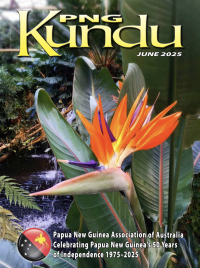57. The Mataungan case – A preliminary comment
Paul Quinlivan’s Snapshots
In previous Snapshots I have tried to take the viewpoint of a fly on the wall – reporting what I saw and heard but playing no part in the event described. In regard to the Mataungan Case, however, I have to say what happened to me and what I said and did, and this is quite foreign to me. It also presents some other problems. These fall into two groups: ‘professional’ ones such as what a lawyer means by ‘claim of right’, ‘admissible evidence’ and so on (which I will include below, in the case itself) and personal ones such as ‘Melchior Tomot was my student’, ‘John Kaputin helped me when I was setting up the Law Society’ and so on. These, with one exception, must await a detailed explanation in later Snapshots. The exception arises from the fact that, for most readers who remember the Mataungan Case, it was about thugs who bashed-up people who favoured turning the Tolai Council into a multi-racial one. In later times there undoubtedly was much strife but up to the day after the first arrest (2 September 1969) I was blissfully ignorant of any anti-Council feeling at all. I certainly knew that there had been no assaults or damage to property or threats to do either (because I would be the first to know) but I was insulated from the fact that someone thought that it was necessary to send SitRep Reports to Canberra twice daily about a ‘dangerous Communist organisation’ known as the Mataungan Association. Since I had been regarded as fairly switched-on, this may be difficult to understand but the fact is that, when constantly travelling on business, one is naturally receptive to what is going on, but once one becomes settled in a new place the situation changes. And, being a shy person, I always found the New Guinea Club a bit overpowering.
The fact is that the 1959 ‘reclassification’ of the Law Department moved all ‘lawyer’ magistracies to the Supreme Court Registrar for ‘administrative’ purposes and, since the last time I had been to Rabaul was in 1958, Crown Law had no knowledge of what was going on until the Tolai Council complained, in July 1965, that the Courts were not fulfilling their function. When I arrived in 1966, I found that, before that complaint, the total of civil cases heard in the Gazelle (cases brought by ordinary people) were: 1961 – 1,261; 1962 – 1,121; 1963 – 1,212; 1964 – 1,438. In my years in Rabaul (and before the Mataungan case of 1969) the relevant figures were: 1966 – 3,354; 1967 – 5,802; 1968 – 11,721.
From this it is clear that I was a fairly busy person! The magistrate’s house was another factor. The 1959 ‘reclassification’ meant that a fully-furnished house with fine china and all the trimmings was built in Rabaul for visiting judges. But the magistrate’s house, up an isolated driveway just beyond the explosives store on the road up Namanula Hill, was allowed to become derelict and when a friend was helping my wife and me unpack, he leant against the main wall of the lounge and the whole wall fell out into the ‘garden’ (also derelict), nearly killing him! Since Soph was pregnant I hastened home each evening to keep her company during the unpacking and the rebuilding of the house around us. Then our four children were born in quick succession and student magistrates started arriving and I had to train them, so for two or three days each week I was doing Rabaul cases each morning and then, in the afternoons, I was travelling the Gazelle Peninsular with the Tolai magistrates, hearing cases in the villages and arriving back in Rabaul towards sunset. So I went straight home. The fact that I spent so much time with those magistrates is important because two were former Council Clerks and all had unlimited loyalties to the new Multi-racial Council so, without intending to do so, they insulated me from the anti-Council feeling which had suddenly come into being now that the Tolai Cocoa Project had paid off the last of its multi-million dollar loan.




